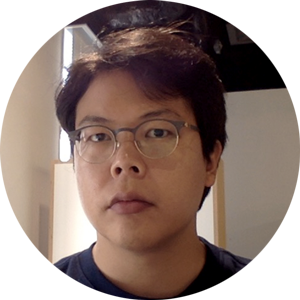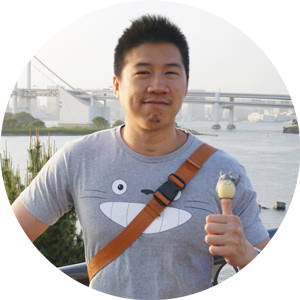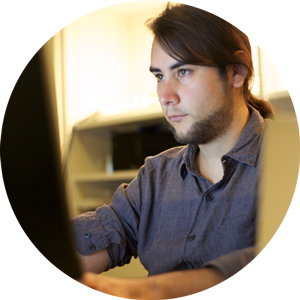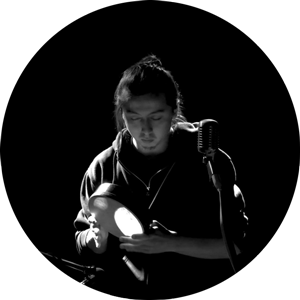Interview with Current International Students
CHO Jae Young Seoul, South Korea
Even before I started studying design, I’ve had a high interest in Japanese culture, and after I started studying it, that naturally lead to an interest in Japanese design and its Culture of Cute. My interest in local mascot characters in that Culture of Cute became my final motivation in deciding to do an exchange in Japan. Even in South Korea, there are more than 200 local mascot characters, but that is merely the beginning stage, so I decided I wanted to learn about the culture of Japanese local mascot characters.
I knew about IAMAS since before I started studying design. When I consulted one of my professors at SADI (Samsung Art & Design Institute) about doing an exchange in Japan, they introduced me to IAMAS, and my interest gradually deepened after that.
The reason I decided to enroll at IAMAS is because, compared to other schools, I felt it had an atmosphere where students could freely do the research they wanted. I wanted to do expressions using technology from a wide range of fields, rather than just confined domains, so I am convinced that coming to IAMAS was the right choice.
Currently, I am doing research on local mascot characters like I had decided when I enrolled. My goal is to propose local mascot characters with new roles, unlike any in the past. However, I want to take advantage of my broad experiences at IAMAS, and not just rely on graphic design.
After graduating, I want to work as a designer in Japan, learning from the Culture of Cute in its real location. After gaining enough experience, I want to return to South Korea and contribute to community design. I believe that I will be happier with the characters I design.
Q. How is life in Ogaki?
Since I was born, I’ve only lived in big cities, so it’s true that I was somewhat worried about a new life in Ogaki (a rural area). But, once I started living here, I didn’t suffer from any inconveniences in transportation or shopping. While I do feel there is a shortage in cultural lifestyle, Ogaki is not far from Nagoya, Kyoto, and Osaka so I visit every now and then.
The best thing I’ve felt living in Ogaki was experiencing the allure of Gifu Prefecture which I hadn’t know about before. Gifu Prefecture isn’t really known abroad, but after traveling here and there in Gifu over the past year, I came to know its allure.
Q. What’s been good, and what’s been difficult at IAMAS?
One of IAMAS’s good points is that I can get my hands on the latest technology sooner than normal. Last year, in a class that used MESH and PEPPER, I had the chance to think about how I can apply new media in my daily life. Also, I think being able to participate in various events held in Gifu Prefecture, and being able to actually confirm my own abilities were also good points. However, a greater variety of exhibitions and lectures are done in Tokyo rather than Ogaki, so, it is a shame that it is difficult to attend the exhibitions and lectures that I want to go to because of geographical reasons.
 CHO Jae Young
CHO Jae YoungBorn 1983
Before enrolling at IAMAS, Cho was in charge of brand design at Samsung Life Insurance. At IAMAS, he is currently researching local mascot characters with new roles.
Interview with International Alumni
After Graduation and Job Seeking
For IAMAS, as a trailblazing school where people study advanced media expressions, many graduates are finding employment at new educational institutions and cultural facilities. In addition, other career choices include IT affiliated businesses, web, graphic and product designers, engineers, artists, starting a new company, advancement to doctoral programs, and other various advancements.
SOPON Kulkijja Bangkok, Thailand
After graduating from IAMAS in 2014, I started working at a CyberAgent Group in Tokyo as a UI designer for social games on smartphones. My duties are to design user experiences and user interfaces for social games on smartphones. I am using all the knowledge I gained from my bachelor’s and master’s studies: graphic design which I studied for my bachelor’s degree in Bangkok, Thailand, and interaction design, technical programming, and knowledge in technology which I studied for my master’s degree at IAMAS.
My graduation thesis is about interaction with plants using new sensor technology from Disney research. IAMAS always supports its students with new technology facilities, tools, and many up-to-date books in their library. Therefore, I could smoothly conduct my research and gain the knowledge necessary for my thesis topic.
When I was studying at IAMAS, they taught me much about technology and programming. As a result, my knowledge in technology improved remarkably and I was able to combine it with my skills in graphic design. This lead me to be able to design and make many interactive works with good-looking interfaces and presentations. I really enjoyed the assignments of making objects at IAMAS.
Moreover, in my opinion, IAMAS gives as many chances to foreign students as they do to Japanese students. They allow foreign students to write their thesis and make their final graduation presentation in English. Therefore, as long as foreign students can communicate in basic Japanese (everyday levels), they would be able to graduate from IAMAS. One of the things I appreciated most about IAMAS is that, out of all the students at IAMAS, many of them Japanese, they let me go on exchange to the Interface Cultures department at the Linz University of Arts in Austria. This shows that IAMAS gives chances to student regardless of their nationality.

SOPON Kulkijja
Born in 1984.
Currently working as a UI designer for social games at Applibot, a CyberAgent Group.
Thesis title: “Plant Plus”, relaxed interaction design. Genre: Sensor and tangible user interface design.
Campaña Rojas José María Mexico
I’m an Interaction Designer and Maker from Mexico. I have a bachelor’s degree in Design from the Metropolitan Autonomous University in Mexico City and a master’s degree in Media Creation from the Institute of Advanced Media Arts and Sciences in Gifu, Japan. I’ve been doing web development for 11 years. Some of my projects solve problems using an interdisciplinary approach and give a special focus to user research and user experience design.
The result of my master’s research at IAMAS, based on a study on 90 designers in Mexico and Japan, was js.bit, a physical device for designers to experience the basic concepts of computer programming. It consisted of a set of 28 boxes or blocks that represent parts of a programming language, such as variables and numbers. The boxes are connected to other boxes to form a program. The real code for this program can be viewed and executed by using an iPad application. The user can have several types of physical outputs, such as a block that lights up in various colors or a block that moves.
As a member of the Enhanced Experience Interaction project, I experimented with electronic devices that emit light, such as an LED Cube, and with projection mapping. I also worked with another student, Tomita Hiroki, to develop a panel that generates electricity when a person jumps on it. We used it in an installation that consisted of several panels and cameras around them. The users would jump on them and when a determined amount of electricity was generated, one of the cameras takes a photograph. It was exhibited at the Aichi Children’s Center and the Miyagi Museum of Art.
After graduating from IAMAS, I joined a company in Tokyo called ediplex Inc. as a System Engineer. There, I’ve been developing the front and back-end of different web services using frameworks such as React JS and Express. I am also doing experimental work in the field of big data and developing apps for various projects.

Campaña Rojas José María
Born in 1989.
http://chemisax.com/en/portafolios
System Engineer @ ediplex inc. in Tokyo, Japan.
Developing the front as well as back end of web services.
www.ediplex.com
Interaction Designer & owner @ design by chemisax, Morelia, Mexico.
Doing mainly web/app development and branding.
www.chemisax.com
Education/Interaction Design
Development of a physical device that resembles a visual programming language for designers to experience programming.
ADilLiJiang NuErMaiMaiTi China
I graduated from IAMAS in March 2015. After graduating, while conducting my own activities in Japan, I worked with the Shanghai Urban Construction Vocational College in China to develop an application for drawing projection figures to be used in their Design Foundation classes. And, in the same year, I received an offer from Tama Art University, and am currently working as an assistant at the university.
For my master’s research, I created an original instrument based on Uyghur traditional music which could also be used in that music. It is a work centered on finding a new path for future traditional music through the creation of traditional music for a new age. This research is constructed from three parts: the first, the creation of a new instrument for traditional music; the second, music composition based on traditional music and which uses the new instrument I created; and the third, the creation of musical notation for this instrument and a performance actually using the instrument.
In my opinion, IAMAS’s system of small groups is probably the best suited for the field of media art. As there are fewer people, everyone seriously considers their individual desires in different places - the time they get to consult with faculty, the number of times they are able to use machinery, exhibition spaces, etc. – and are doing their best so they are able to create good works. As my major in college wasn’t art, when I first enrolled at IAMAS, I was quite perplexed. At that time, I received advice and was taught methods for artistic thinking by various teachers, which was very helpful. In particular, I am still very grateful to Professor Masahiro Miwa, who was my advisor at the time.

ADilLiJiang NuErMaiMaiTi
Born in 1986.
Currently works as an assistant at the Department of Scenography Design, Drama and Dance at Tama Art University, and specializes in musical representation. At IAMAS, did research and creation of musical instruments based on traditional music.
IMG SRC Group | Infofarm co.,Ltd. | KAYAC Inc. | KORG INC. | CyberAgent, Inc. | Shinto Tsushin Co., Ltd. | Bascule Inc. | Sony Corporation | TAK CO., LTD. | TEAMLAB INC. | HAKUHODO i-studio Inc. | Nintendo Co., Ltd. | YUKAI ENGINEERING INC. | SK telecom (South Korea)
NTT InterCommunication Center | The Museum of Art, Kochi | Shizuoka Performing Arts Center | sendai mediatheque | National Museum of Emerging Science and Innovation | Yamaguchi Center for Arts and Media
Joshibi University of Art and Design | Seian University of Art and Design | Tama Art University | Tokyo University of the Arts | Nagoya University of Arts and Sciences | Nagoya Zokei University of Art & Design | Hiroshima City University | Musashino Art University
ALLIANCE PORT, LLC. | aitia | Ag Ltd. | GOCCO. | Semitransparent Design | soneru | MATHRAX, LLC. | trigger device Y.K. | Douga Mawari | Matilde inc. | METAPHOR Inc. | rhizomatiks co., ltd.
Gifu University, Graduate School of Engineering, Doctorate Program | Tokyo University of the Arts, Doctoral Program in Film and New Media Studies | Nagoya University, Graduate School of Information Science, Doctoral Program | Kyoto City University of Arts, Graduate School of Arts – Doctoral Course | Linz University of Art and Industrial Design, Doctoral Program (Austria) | Royal College of Art (England)
Areas and Number of International Students
| 2016 | 1 | South Korea |
| 2015 | 1 | South Korea |
| 2014 | 1 | South Korea |
| 2013 | 3 | South Korea・Russia・ Mexico |
| 2012 | 2 | China・Thailand |
| 2011 | 1 | South Korea |
| 2010 | 3 | South Korea |
| 2009 | 1 | South Korea |
| 2007 | 2 | France・Switzerland |
| 2006 | 1 | South Korea |
| 2005 | 2 | South Korea・Malaysia |
| 2004 | 1 | China |
| 2002 | 1 | Canada |
Entrance Examinations
2017 Commendation Entrance Examination
Submission Period for Applications: June 10 - June 17, 2016
Entrance Examination: July 2, 2016
Announcement of Results: July 15, 2016
Admission Paperwork Deadline: August 5, 2016
2017 First Round Entrance Examination
Submission Period of Eligibility Evaluation: September 7- September 14, 2016
Submission Period for Applications: September 23- September 30, 2016
Entrance Examination: October 15, 2016
Announcement of Results: October 21, 2016
Admission Paperwork Deadline: November 11, 2016
2017 Second Round Entrance Examination
Submission Period of Eligibility Evaluation: January 5- January 12, 2017
Submission Period for Applications: January 20- January 27, 2017
Entrance Examination: February 11, 2017
Announcement of Results: February 17, 2017
Admission Paperwork Deadline: March 3, 2017
